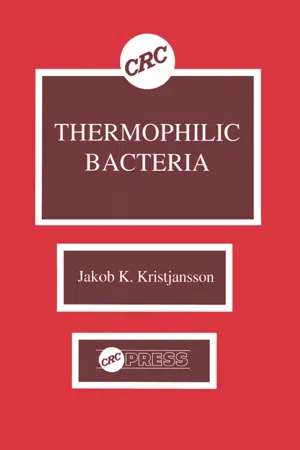
- 240 pages
- English
- ePUB (mobile friendly)
- Available on iOS & Android
Thermophilic Bacteria
About this book
Thermophilic Bacteria is a comprehensive volume that describes all major bacterial groups that can grow above 60-65°C (excluding the Archaea). Over 60 different species of aerobic and anaerobic thermophilic bacteria are covered. Isolation, growth methods, characterization and identification, ecology, metabolism, and enzymology of thermophilic bacteria are examined in detail, and an extensive compilation of recent biotechnological applications and the properties of many thermostable enzymes are also included.Major topics discussed in the book include a general review on thermophilic bacteria and archaea; heterotropic bacilli; the genus Thermus; new and rare genera of aerobic heterophophs, such as Saccharococcus, Rhodothermus, and Scotohermus; aerobic chemolithoautotrophic thermophilic bacteria; obligately anaerobic thermophilic bacteria; and hyperthermophilic Thermotogales and thermophilic phototrophs. Extensive bibliographies are also provided for each chapter. The vast amount of information packed into this one volume makes it essential for all microbiologists, biochemists, molecular biologists, and students interested in the expanding field of thermophilicity. Biotechnologists will find the book useful as a source of information on thermophiles or thermostable enzymes of possible industrial use.
Frequently asked questions
- Essential is ideal for learners and professionals who enjoy exploring a wide range of subjects. Access the Essential Library with 800,000+ trusted titles and best-sellers across business, personal growth, and the humanities. Includes unlimited reading time and Standard Read Aloud voice.
- Complete: Perfect for advanced learners and researchers needing full, unrestricted access. Unlock 1.4M+ books across hundreds of subjects, including academic and specialized titles. The Complete Plan also includes advanced features like Premium Read Aloud and Research Assistant.
Please note we cannot support devices running on iOS 13 and Android 7 or earlier. Learn more about using the app.
Information
Chapter 1
THERMOPHILIC BACTERIA
Jakob K. Kristjansson and Karl O. Stetter
TABLE OF CONTENTS
I. INTRODUCTION
Table of contents
- Cover
- Title Page
- Copyright Page
- Preface
- The Editor
- Contributors
- Table of Contents
- Chapter 1 Thermophilic Bacteria
- Chapter 2 Heterotrophic Thermophilic Bacilli
- Chapter 3 The Genus Thermos
- Chapter 4 The Heterotrophic, Thermophilic Genera Thermomicrobium, Rhodothermus, Saccharococcus. Acidothermus, and Scotothermus
- Chapter 5 The Aerobic, Chemolithoautotrophic, Thermophilic Bacteria
- Chapter 6 The Anaerobic Thermophilic Bacteria
- Chapter 7 The Thermotogales: Hyperthermophilic and Extremely Thermophilic Bacteria
- Chapter 8 Thermophilic Phototrophs
- Index